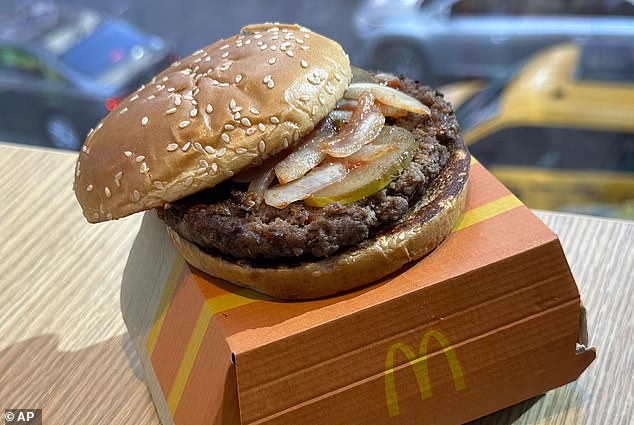Food safety experts have revealed their biggest fast food restaurant red flags amid a deadly bacteria outbreak.
This week, fast food giant McDonald’s came under fire as 75 people in 13 states have been sickened with E coli, a bacterial infection that kills up to one in five patients, after eating the chain’s Quarter Pounder.
Of those, 22 have been hospitalized and one older man in Colorado has died from the infection. Two others are fighting for their lives due to severe kidney injuries stemming from their infections
Health officials have suggested that widespread illness could be from the chopped onions on the burger, which have been pulled from about one in five US McDonald’s locations, as well as other chains like Burger King.
As the outbreak unfolds, experts have warned to stay vigilant of unsanitary practices at fast food places that could increase your risk of getting sick.

As a deadly E coli outbreak has been linked to McDonald’s Quarter Pounders (pictured here), food safety experts revealed their fast food restaurant red flags
Mitzi Baum, CEO at nonprofit Stop Foodborne Illness, told DailyMail.com: ‘From the farms growing ingredients to the restaurants serving you food, each partner in the food chain needs to prioritize food safety to prevent these outbreaks from happening.’
Dr Shanina Knighton, a research associate professor at Case Western Reserve University, said she avoids restaurants where food is served in front of you, with Chipotle and Sweetgreen two of the most popular examples.
She told DailyMail.com: ‘Personally, I avoid restaurants that use a build-and-serve model, where employees assemble meals or bowls in front of customers.
‘In these setups, I’ve observed workers switching between tasks—handling utensils, touching food, and operating machines or registers — without washing their hands and changing their gloves.
‘They often ring up orders, handle credit cards, and touch payment screens, creating numerous opportunities for cross-contamination.’
Dr Knighton also noted hand sanitizers may be too close to the food prep area or registers, raising the risk of harmful chemicals contaminating the food.
Chipotle in particular made headlines when more than 1,110 people were sickened with norovirus, the most common type of food poisoning, between 2015 and 2018.
The outbreak was traced back to ‘adulterating’ the chain’s foods, which meant adding undeclared ingredients to lower costs and boost appearance.
Also in 2015, 55 people in 11 states were sickened and 22 were hospitalized from E. coli from the fast-Mexican chain, though the exact cause was never found.
And recent data from Iwaspoisoned.com, which compiles food poisoning reports, found that based on self reporting, Sweetgreen was linked to an 11-fold greater risk of illness compared to the average risk.
Dr Knighton also advised paying attention to how fast food workers handle condiments.
She said: ‘Pre-packaged condiments should never come into contact with food, as they are often stored in boxes or placed on surfaces that may not be sanitized.
‘If the packaging touches food, it can introduce contaminants.
‘Dirty or unswept floors are also a red flag, signaling poor cleaning practices that may extend into food prep areas.’
And if the workers are spending a lot of time on their phones, it may best to take your business elsewhere.
Dr Knighton added: ‘Phones are known to be 10 times dirtier than a toilet seat and can harbor dangerous bacteria like E. coli. If workers fail to wash their hands after using their phones, it creates a serious contamination risk.’
She said that even wearing fake nails can pose issues, as they can get caught or torn on gloves, making them less effective.
Ms Baum also suggested paying attention to employees who are touching their hair or phone without washing their hands, as well as checking to see if the front door looks clean.
Dr Darin Detwiler, a food safety expert at Northeastern University in Boston, previously told DailyMail.com he checks out the bathroom at every restaurant before sitting down to eat.
He said: ‘If they’re serious about sanitation, that’s a place that will show you the restaurant is clean.’
Dr Detwiler looks for tell-tale signs of a neglected restroom like dirty toilets, lack of paper towels, and grimy countertops.
A 2018 Harris Poll found two-thirds of American customers would avoid a restaurant if reviews mentioned restroom odors, and 63 percent said they would steer clear if they knew clogged toilets were a common occurrence.

Dr Shanina Knighton, a research associate professor at Case Western Reserve University, said that she avoids restaurants where employees build food in front of the customers, like Chipotle, due to cross contamination
‘I have literally walked out of restaurants, even if I was hungry and wanted to eat there, because their bathroom was so disgusting,’ Dr Detwiler said.
‘I don’t even want to know what’s going on in the kitchen.’
To reduce the risk of foodborne illness, Dr Knighton suggested avoiding ‘high-risk items like raw vegetables or undercooked meats, and don’t hesitate to leave if you notice unsanitary conditions — such as dirty floors, poorly managed condiments, or employees with artificial nails compromising glove effectiveness.’
Toby Amidor, a nutrition expert in New York and author of Health Shots, told DailyMail.com: ‘If you walk into any food service establishment and see many flies, or bugs, a big mess in the back, no hand washing or glove wearing, employees working when they are sick – really, a combination of these poor practices – that may give you some insight in how [the restaurant] views food safety practices.
‘In terms of cross-contamination, you always use separate cutting boards, surfaces, and utensils to prep raw meat and cooked foods like raw versus cooked burgers or raw burgers and fresh fruit.’
And in the midst of an outbreak, Ms Amidor said: ‘There is also nothing wrong with a bit of cooking at home if you’re unsure of the food safety until the issue is resolved.’
This article was originally published by a www.dailymail.co.uk . Read the Original article here. .


